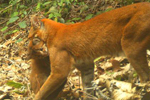Elusive, little-known cats are ‘just unbelievably sneaky’
The African golden cat is arguably the continent’s least known feline, inhabiting dense tropical forests, almost never seen, and, of course, long-upstaged by Africa’s famous felines: lions, cheetahs, and leopards. But a few intrepid scientists are beginning to uncover the long-unknown lives of these wild cats, which are about double the size of a domestic cat. Most recently, researchers working in Uganda’s Kibale National Park have captured remarkable photos of African golden cats…with kittens.
“Since 2010, we have conducted seven camera surveys and accumulated nearly 300 independent golden cat captures in over 18,000 trap days,” David Mills with the Wildlife Conservation Society Uganda and Panthera told mongabay.com. Still, the cats are so secretive that it took the project three years to capture photos of African golden cat kittens, which Mills believe are the first verifiable photos of this jungle cat’s young.
But the rare photos of the kittens are already telling scientists something new about this species.
“Our camera trap photographs have shown that golden cat color phases are roughly equally represented and do not show sex bias, so we assumed that mothers of each color produce kittens of different colors as well. These photographs show that indeed grey and red phase mothers produce grey kittens. Another photograph that is less clear also suggests a red adult with red juvenile,” David Mills noted.
The research on African golden cats in Kibale National Park has been complimented by similar research in Gabon. Currently, the IUCN Red Lists categorizes the species as Near Threatened with impacts including deforestation, prey decline due to the booming bushmeat trade, and by-catch in wire snares. Killing the cats for their skins and as festishes is a problem in some countries as well.

An African golden cat kitten on the run. Photo by: David Mills/WCS/Panthera.

Close-up of a mother African golden cat with her kitten. Photo by: David Mills/WCS/Panthera.
“Before our studies started, there was no imperial data on African golden cats,” said Mills. “Sightings were extremely rare. Even field assistants in Kibale who have spent five days a week in the forest for the past 20 years have only seen them a few times…This secretive nature is probably partly due to the fact that they are forest dependent and are therefore always able to slip away unnoticed.”
Mills, who has never seen an African golden cat in the flesh himself, said that camera trapping has proven that the species is sometimes active during the day. He also said it’s possible that people see the cats from time-to-time, but mistake them for duikers, given their similar size and color.
“Researchers and field assistants will assume that everything red or grey and charging away through the undergrowth is a duiker,” he said, adding that the cats are “just unbelievably sneaky.”
Still, Mills said he wouldn’t have the cats any other way.
“[The] fact that a species can be consistently, but exceedingly rarely, reported and that it had been completely overlooked due to the apparent difficulty in gathering any kind of data on its ecology, made it a very interesting subject. It’s very possible that I am masochistic, but I have nevertheless enjoyed the experience immensely.”

A pair of African golden cat kittens. Photo by: David Mills/WCS/Panthera.

Mom and kitten. Photo by: David Mills/WCS/Panthera.
Related articles
|
Video: camera trap catches jaguar hunting peccaries (01/26/2015) Catching a jaguar on a remote camera trap in the Amazon is a rare, happy sight. But catching a jaguar attempting to ambush a herd of peccaries is quite simply astonishing. |
|
Video: camera trap catches jaguar hunting peccaries (01/26/2015) Catching a jaguar on a remote camera trap in the Amazon is a rare, happy sight. But catching a jaguar attempting to ambush a herd of peccaries is quite simply astonishing. |
|
Video: clouded leopards and elephants grace drowned forest in Thailand (01/21/2015) Camera trap video from Khlong Saeng Wildlife Sanctuary in southern Thailand has revealed an impressive array of wildlife, including scent-marking clouded leopards and a whole herd of Asian elephant. The camera traps were set by HabitatID, an organization devoted to using remote camera traps to prove to government officials that wildlife still flourishes in forgotten places. |
|
India’s tiger population up by more than 500 animals in four years (01/20/2015) The tiger is in major trouble. In 1900, the global population was over 100,000 animals; today, it is on the precipice of extinction, hovering around just 3,000. In response, tiger range countries have pledged to double to the population by 2022. But there has been little evidence of success until now: India has announced that its tiger population has jumped a remarkable 29 percent in the last four years. |
|
Mother and cub: researchers photograph rare cat with cub in Sumatra (01/13/2015) Researchers working in Kerinci Seblat National Park have captured a remarkable image of a mother Asian golden cat (Catopuma temminckii) carrying her young in her mouth. The image was taken in mid-2014 as reported by Mongabay Indonesia by the Sumatran Tiger Research Team. |
|
Ocelots live in super densities on Barro Colorado Island (12/18/2014) By comparing camera trapping findings with genetic samples taken from feces, biologists have determined that the density of ocelots on Barro Colorado Island in Panama is the highest yet recorded. There are over three ocelots per every two square kilometers (0.77 square miles) on the island. |
